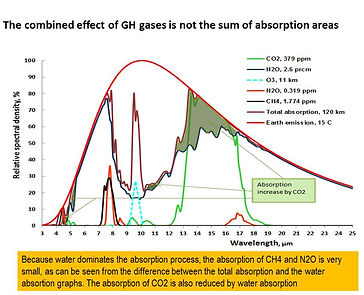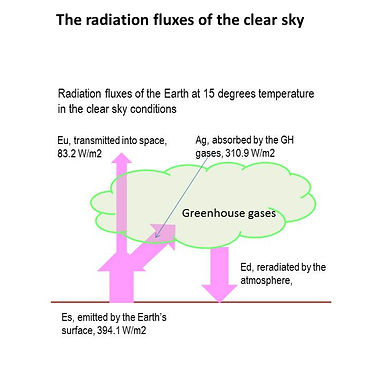The downward flux by the atmosphere is the same as the real greenhouse effect. This flux is excatly the same as the sum of four energy fluxes: LW radiation absorption 155.6 + SW radiation absotpion 75.0 + Latent heating 90.8 + 24.2 = 345.6 W/m2
ClimatExam Scientific analyses of the climate change and global warming by Dr. Antero Ollila



Climate change science


Scientific approach
The purpose of these pages is to analyze in the scientific way the basic aspects of the climate. Especially the author analyzes the warming effects of carbon dioxide (CO2) and other greenhouse gases.
The material on this pages is based mainly on the scientific papers published by the author.
Accuracy of the spectral analysis method
The accuracy of spectral calculations can be checked using the real atmosphere conditions. The two studies show that the CO2 absorption in dry and clear atmosphere conditions that generally the calculation accuracy is below 1 %.
However the question of water vapor continuum is still unclear. The continuum means that the strong absorption bands of water have effects also on the neighboring bands. The continuum effects have been estimated by semi-empirical formulas in the spectral calculation tools. Spectral Calculator does not use water continuum effects in its atmospheric path calculations.
There is a simple way to check the accuracy of the atmospheric spectral calculations carried out by Spectral Calculator. In the clear sky conditions according to the Kirchhoff’s rule, the LW downward flux Ed emitted by the atmosphere should be the same as the total absorption Ag due to the absorption caused by the GH gases. According to the synthesis analysis of Stephens et al. [1], the measured value of downward fluxes vary between 309.2 - 326 Wm-2 in 13 independent studies the average value being 314.2 Wm-2. The author has calculated the flux value of Ag to be 310.9 Wm-2 using the Spectral Calculator’s formula for water vapor. The conclusion is that Spectral Calculator gives results, which are near to the measured values of the real atmosphere and the difference is in average about 1.0 %. This difference is well inside the error margin of ±10 Wm.2 estimated to be the accuracy of measured LW fluxes [2].
Some researchers apply water continuum calculation formula in their analyses. It means that the absorption by water is stronger and the absorption by CO2 is weaker. In this respect the results of my papers are "conservative" in respect to CO2, which means that the effects of CO2 are not certainly too weak.
References:
[1] G. L. Stephens, M. Wild, P. W. Stackhouse Jr., T. L’Ecuyer, S. Kato and D. S. Henderson, “The global character of the flux of downward longwave radiation, ” Journal of Climate, vol. 25, 2012, pp. 2329-2340.
[2] D. D. Turner, D.C. Tobin, S. A. Clough, P. D. Brown, R. G. Ellingson, E. J. Mlawer, R. O. Knuteson , H. E. Revercomb, T. R. Shippert, W. L. Smith and M. W. Shephard, “The QME AERI LBLRTM: A closure experiment for downwelling high spectral resolution infrared radiance,” Journal of Atmospheric Sciences, vol. 61, 2004, pp. 2657-2675.